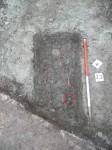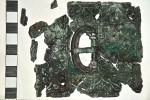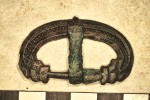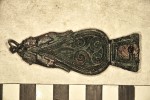 A team from University of Leicester Archaeological Services (ULAS) excavating an ancient cemetery in Leicester have unearthed an elaborate bronze belt set typically worn by military commanders or government officials in Late Roman Britain. The cemetery on Western Road was just outside the old Roman city walls near the Fosse Way, an important Roman road which connected the military camps at Isca (Exeter) and Lindum (Lincoln). Archaeologists unearthed 83 skeletons, one of which, in grave 23, was found with the bronze buckle set next to his right hip. It dates to the second half of the 4th century or the early 5th century.
A team from University of Leicester Archaeological Services (ULAS) excavating an ancient cemetery in Leicester have unearthed an elaborate bronze belt set typically worn by military commanders or government officials in Late Roman Britain. The cemetery on Western Road was just outside the old Roman city walls near the Fosse Way, an important Roman road which connected the military camps at Isca (Exeter) and Lindum (Lincoln). Archaeologists unearthed 83 skeletons, one of which, in grave 23, was found with the bronze buckle set next to his right hip. It dates to the second half of the 4th century or the early 5th century.
 The set is composed of three parts: a belt plate, a buckle and the end of a strap. The belt plate is made from a thin sheet of bronze decorated in the chip-carved style, meaning parts of the sheet were carved away leaving behind an interlocking spiral design. The buckle is decorated with dolphin heads. The strap end has a crouching dog on both sides of the tapered end. The buckle sits in the middle of the plate which would have been riveted to a wide leather belt. The strap that threads through the buckle had bronze cap. The metal parts are all that have survived of the belt, and that’s remarkable enough as it is, because the belt plate is so thin, it could easily have corroded into nothingness.
The set is composed of three parts: a belt plate, a buckle and the end of a strap. The belt plate is made from a thin sheet of bronze decorated in the chip-carved style, meaning parts of the sheet were carved away leaving behind an interlocking spiral design. The buckle is decorated with dolphin heads. The strap end has a crouching dog on both sides of the tapered end. The buckle sits in the middle of the plate which would have been riveted to a wide leather belt. The strap that threads through the buckle had bronze cap. The metal parts are all that have survived of the belt, and that’s remarkable enough as it is, because the belt plate is so thin, it could easily have corroded into nothingness.
 Other examples of this type of buckle have been found in Late Roman cemeteries in London, Winchester, Dorchester on Thames in Britain, as well as in Oudenburg, Belgium, but they are rare. Pictorial evidence indicates these belts were worn by the elites to convey their power and authority.
Other examples of this type of buckle have been found in Late Roman cemeteries in London, Winchester, Dorchester on Thames in Britain, as well as in Oudenburg, Belgium, but they are rare. Pictorial evidence indicates these belts were worn by the elites to convey their power and authority.
 This elite fellow’s grave was not built to convey power and authority. It was simply cut into mudstone on the bank of the River Soar and held the remains of an adult man between 36 and 45 years of age at the time of his death. Osteological evidence indicates he was sick as a child, surviving bouts of illness to reach adulthood in comparatively good health. As an adult, he fractured his left forearm in a type of injury known as a “parry fracture” because it is usually incurred by raising an arm to parry a blow. The fracture healed on its own, but his wrist suffered permanent damage from it. He suffered from muscle damage in his upper right arm and shoulder. This could have been caused by exertion either in manual labor or in athletic pursuits like lifting and throwing. They are also commonly seen in professional fighters like gladiators and soldiers.
This elite fellow’s grave was not built to convey power and authority. It was simply cut into mudstone on the bank of the River Soar and held the remains of an adult man between 36 and 45 years of age at the time of his death. Osteological evidence indicates he was sick as a child, surviving bouts of illness to reach adulthood in comparatively good health. As an adult, he fractured his left forearm in a type of injury known as a “parry fracture” because it is usually incurred by raising an arm to parry a blow. The fracture healed on its own, but his wrist suffered permanent damage from it. He suffered from muscle damage in his upper right arm and shoulder. This could have been caused by exertion either in manual labor or in athletic pursuits like lifting and throwing. They are also commonly seen in professional fighters like gladiators and soldiers.
 The belt buckle set and other artifacts discovered at the Western Road excavation will be on display for one day only this Sunday, July 10th, at the Jewry Wall Museum in Leicester from 11:00AM through 4:00 PM. It’s a free event in conjunction with the upcoming Festival of Archaeology. Archaeologists from the dig will be present to talk to visitors about their work and the finds, including the belt buckle.
The belt buckle set and other artifacts discovered at the Western Road excavation will be on display for one day only this Sunday, July 10th, at the Jewry Wall Museum in Leicester from 11:00AM through 4:00 PM. It’s a free event in conjunction with the upcoming Festival of Archaeology. Archaeologists from the dig will be present to talk to visitors about their work and the finds, including the belt buckle.